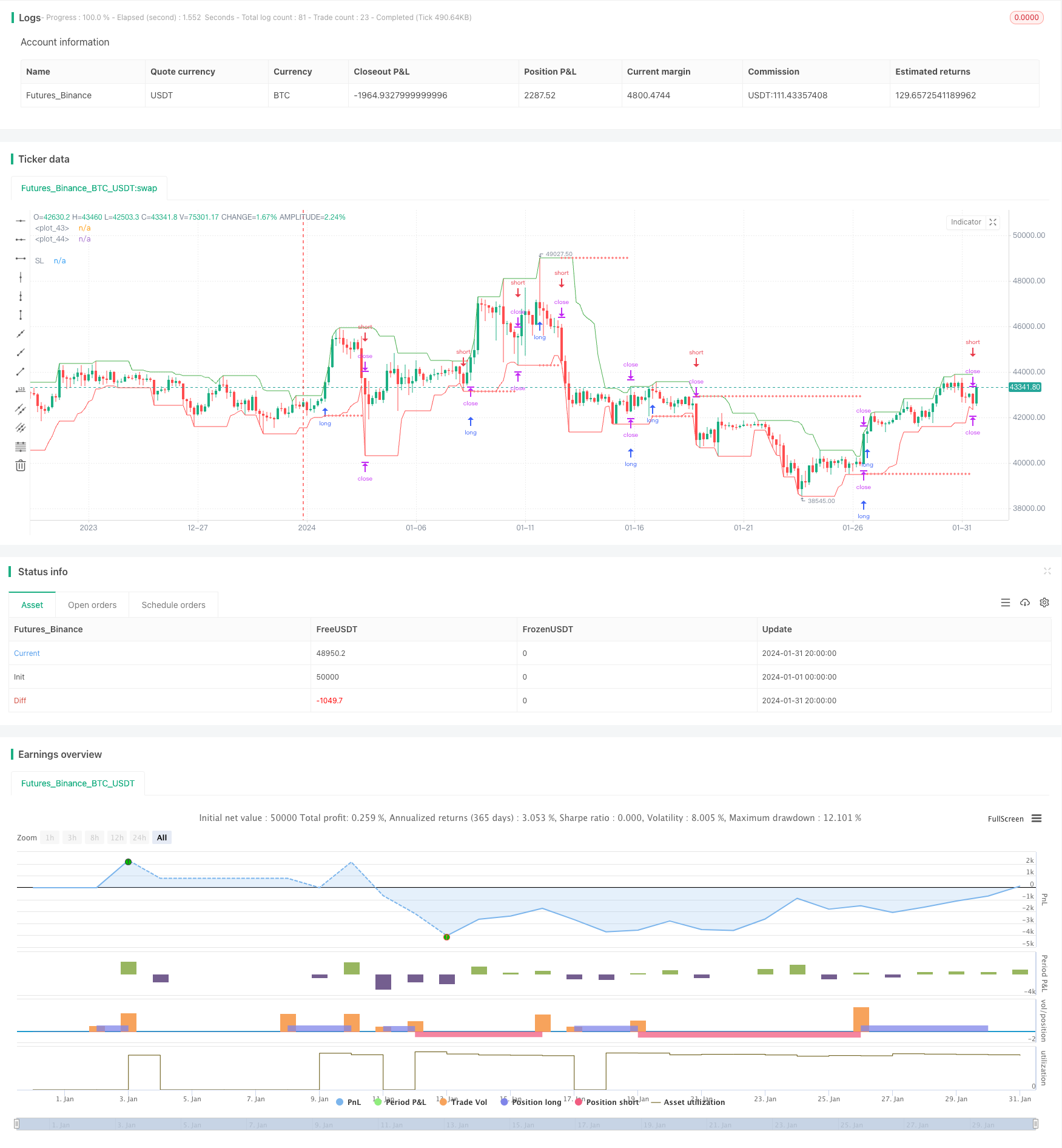
概述
高低点突破策略是一个基于高低点识别的长线期波动策略。该策略在策略方向参数方向上,在突破最近一个特定窗口期的最高价时做多,突破最近一个特定窗口期的最低价时做空。
策略原理
该策略通过输入参数设置查看最近N根K线的最高价和最低价,即波动的高低点,根据方向参数判断策略方向。在做多时,当价格突破最近N根K线内的最高点时按照止赢方式入市做多;当价格跌破最近N根K线内的最低点时按照止损方式入市做空。
此外,该策略还设定了止损位。在开仓做多后,止损线设置为最低价附近;做空后,止损线设置为最高价附近。这可以有效规避单边行情带来的巨大亏损。
优势分析
该策略最大优势是能抓住高低点附近的关键波动,顺势而为,实现盈利。另外设置止损线有效控制了风险。
具体优势有:
策略思路清晰,通过突破高低点来判断入场和出场。
利用swing高低点来寻找反转机会,这是技术分析的经典做法。
有止损设置来控制风险,可以避免单边行情带来的巨亏。
代码结构清晰,容易理解和修改。
可输入不同参数来优化策略,如调整最高最低点周期数等。
风险分析
该策略的主要风险在于高低点判断不准带来的错误交易。具体风险包括:
最高最低点可能出现错误突破带来错误入场。
突破点附近可能有巨大的止损被触发。
趋势品种容易形成花费巨大才能确定高低点。
参数设置不当也会影响策略表现。
对应解决方法包括:
优化参数,调整最高最低点判断的周期数。
加大止损幅度。
区分品种特性,避免在趋势品种使用。
采用机器学习方法动态优化参数。
策略优化方向
该策略可以从以下方向进行优化:
最高最低点周期数优化:当前固定周期数,可以改为动态优化以避免固定模式带来的过优化。
增加止损止盈优化:可以基于ATR、波动率等指标动态调整止损幅度。
结合多个时间周期:可以在更高时间周期确定趋势,低时间周期决定入场。
增加机器学习:使用神经网络等方法预测潜在高低点突破概率,提升效果。
优化止损算法:改进算法以在保证止损的前提下尽量减少无效止损被触发的情况。
总结
高低点突破策略整体是一个非常实用的长线量化策略。它通过捕捉高低点附近的反转机会获利,并设置止损来控制风险,从而在保证收益的同时也控制了回撤。该策略参数设置灵活,思路清晰,是值得推荐的一个策略思路。后续可通过引入动态优化、机器学习等方式以进一步完善该策略。
/*backtest
start: 2024-01-01 00:00:00
end: 2024-01-31 23:59:59
period: 4h
basePeriod: 15m
exchanges: [{"eid":"Futures_Binance","currency":"BTC_USDT"}]
*/
// This source code is subject to the terms of the Mozilla Public License 2.0 at https://mozilla.org/MPL/2.0/
// © tweakerID
// Long term strategy for managing a Crypto investment with Swing Trades of more than 1 day. The strategy buys with a
// stop order at the Swing High price (green line) and sells with a stop order at the Swing Low price (red line).
// The direction of the strategy can be adjusted in the Inputs panel.
//@version=4
strategy("Swing Points Breakouts", overlay=true, default_qty_type=strategy.percent_of_equity, default_qty_value=100, initial_capital=10000, commission_value=0.04)
direction = input(0, title = "Strategy Direction", type=input.integer, minval=-1, maxval=1)
strategy.risk.allow_entry_in(direction == 0 ? strategy.direction.all : (direction < 0 ? strategy.direction.short : strategy.direction.long))
//Inputss
i_SL=input(true, title="Use Swing Lo/Hi Stop Loss & Take Profit")
i_SwingLow=input(10, title="Swing Low Lookback")
i_SwingHigh=input(10, title="Swing High Lookback")
i_reverse=input(false, "Reverse Trades")
i_SLExpander=input(defval=0, step=1, title="SL Expander")
//Strategy Calculations
SwingLow=lowest(i_SwingLow)
SwingHigh=highest(i_SwingHigh)
//SL & TP Calculations
bought=strategy.position_size != strategy.position_size[1]
LSL=valuewhen(bought, SwingLow, 0)-((valuewhen(bought, atr(14), 0)/5)*i_SLExpander)
SSL=valuewhen(bought, SwingHigh, 0)+((valuewhen(bought, atr(14), 0)/5)*i_SLExpander)
islong=strategy.position_size > 0
isshort=strategy.position_size < 0
SL= islong ? LSL : isshort ? SSL : na
//Entries and Exits
strategy.entry("long", true, stop=i_reverse?na:SwingHigh, limit=i_reverse?SwingLow:na)
strategy.entry("short", false, stop=i_reverse?na:SwingLow, limit=i_reverse?SwingHigh:na)
if i_SL
strategy.exit("longexit", "long", stop=LSL)
strategy.exit("shortexit", "short", stop=SSL)
//Plots
plot(i_SL ? SL : na, color=color.red, style=plot.style_cross, title="SL")
plot(SwingLow, color=color.red)
plot(SwingHigh, color=color.green)